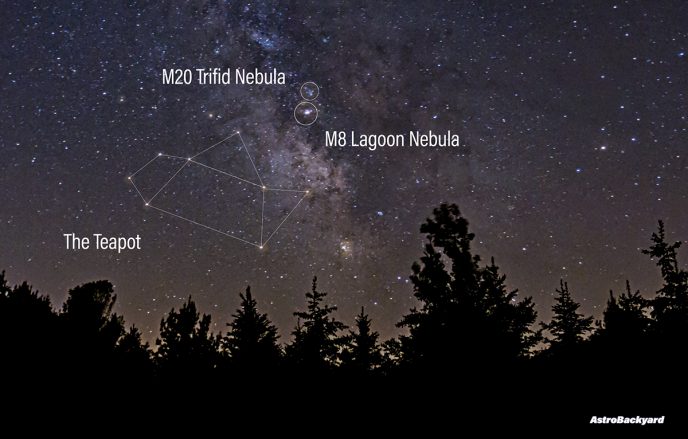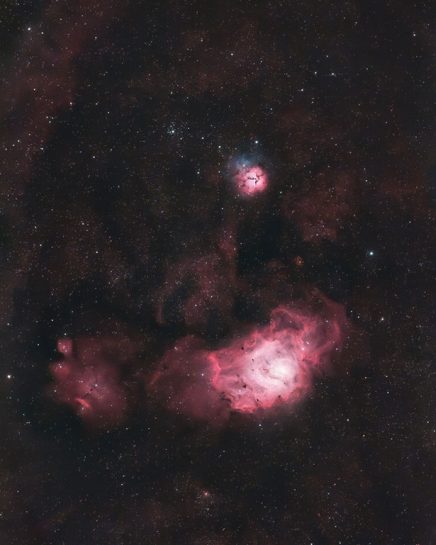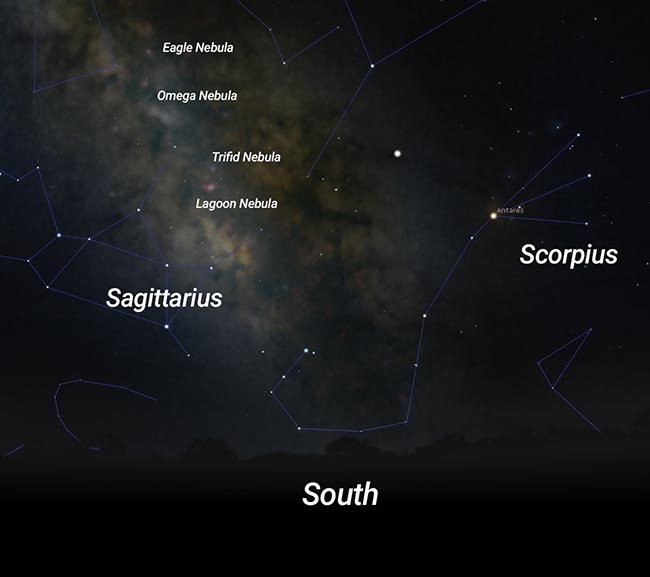The Trifid Nebula
The Trifid Nebula is a colorful combination of nebulae types that unite to create a celestial work of art. Cataloged as Messier 20, the Trifid Nebula is a magnitude +6.3 H II region of interstellar gas in the constellation Sagittarius.
It lies approximately 5,000 light-years away in a nebula-rich, crowded starfield area of the night sky. It is often photographed next to the nearby emission nebula, M8 (the Lagoon Nebula).
The Trifid Nebula was discovered by Charles Messier on June 5th, 1764, and number 20 of the 110 Messier objects in his catalog. Its name means “divided into three lobes”, as the dark nebula in this object creates the apparent “gaps” within the emission nebula portion of the Trifid.
M20 – The Trifid Nebula in Sagittarius.
This detailed NASA image focuses on the central region of the Trifid Nebula and displays three “wing-like” bands of dust. Using an infrared camera, scientists can reveal filaments of luminous gas and newborn stars.
Messier 20 includes a unique combination of an open cluster of stars, an emission nebula, a reflection nebula, and a dark nebula. All of these elements combine to create one of the most stunning deep-sky objects in our night sky.
M20 is an exquisite deep sky astrophotography target for amateur photographers, and worthy of extra attention through any telescope. It is one of the brightest nebulae in the night sky.
The close-up picture of the Trifid Nebula shown at the top of this page was captured using a Sky-Watcher Esprit 150 telescope on a tracking equatorial mount.
For those looking to capture images like this, see my recommended list of astrophotography telescopes.
Trifid Nebula Details
- Designation: M20, NGC 6514, Sharpless 30
- Constellation: Sagittarius
- Type: Emission Nebula, Reflection Nebula, Dark Nebula
- Distance: 5,200 light-years from Earth
- Size: 42 light-years in diameter
- Apparent Dimensions: 28 arcminutes
- Visual Magnitude: 6.3
As you can see in the image below, the Trifid Nebula lies very close to the open cluster, Messier 21 (NGC 6531) With an apparent magnitude of 6.5, many of the stars inside of the M21 cluster can be seen through a small telescope or binoculars.
M21 shares no apparent connection to M20, and M21’s stars are much older (about 8 million years old) than the younger Trifid Nebula.
The Trifid Nebula captured with an amateur astrophotography setup.
What Type of Nebula is M20?
A unique trait of the Trifid Nebula is its ability to illustrate three different types of astronomical nebulae in a single deep-sky object.
A red emission nebula (light from hydrogen atoms), a blue reflection nebula (dust reflected by starlight), a and dark nebula, with dense dust that silhouettes the light beneath it.
The Trifid Nebula is relatively young, as far as space goes. M20 is a mere 300,000 years old, which makes it one of the youngest star-forming regions in our sky.
The emission nebula portion of M20 is illuminated by the light of the young, hot, massive class O stars that form the open cluster.
Related Post: What is a Nebula?
How Big is the Trifid Nebula?
To give you an idea of the apparent size of this nebula in our night sky, it almost covers the area of a full moon. The Trifid Nebula is about 40 light-years across but is a little too faint to see with the unaided eye.
Using a pair of binoculars, the Trifid Nebula, and nearby Lagoon Nebula become quite obvious when observing from a dark sky site. Although my backyard is a Class 7 on the Bortle Scale, I can still see the Trifid Nebula through the eyepiece of my Dobsonian telescope.
It is a great object to view through the telescope eyepiece from a dark sky location and is a popular choice at star parties.
Amateur Astrophotography
This star-forming region is an extremely popular choice for amateur astrophotographers in their backyard. The Trifid Nebula was the subject of the following video on my YouTube channel in August 2016.
I used a DSLR camera and a refractor telescope to photograph this nebula from my backyard. To create the final image, I combine several long exposure images together to create an image with an improved signal-to-noise ratio.
For a behind-the-scenes look at how I photographed the Trifid Nebula from my backyard using a camera and telescope, please watch the video below:
Through photography, we can truly enjoy the intense colors of the Trifid Nebula that are not possible to observe visually. A light pollution filter will help to separate this nebula from a washed-out city sky.
Through image stacking and image processing, we can bring out the beautiful blue and pink colors of the Trifid Nebula. For help with astrophotography image processing, please see my premium image processing guide.
How to find the Trifid Nebula
In the northern hemisphere, the best time of year to observe M20 is in the summer, particularly in the months of June, July, and August. The nights are warm and short.
Through a telescope, the Trifid Nebula appears as a bright and peculiar object in a highly observed and photographed area of Sagittarius.
To find it, you will need to point your binoculars or telescope towards the Teapot asterism in the constellation Sagittarius.
The shape of the celestial teapot is a recognized star pattern, but not an official constellation. The teapot shape should become obvious to your eyes once you know where to look.
From mid-northern latitudes, the Teapot lies due south and is highest in the sky around midnight by early July.
Because Sagittarius doesn’t rise very high in our northern sky, you may have to deal with trees or other obstructions that are blocking your view of the southern horizon.
The location of the teapot asterism in Sagittarius.
An easy way to confirm the location of M20 (and other deep-sky objects in the night sky) is to use a planetarium app on your smartphone. I prefer to use Stellarium, but SkySafari 6 is another great option to consider.
See my list of astronomy and stargazing apps for your mobile phone for a complete list of helpful tools.
Star-hopping from the Teapot
As seen in the star chart above, you can use the stars on the right-hand side of the Teapot asterism to star-hop over to the Trifid Nebula. It may help if you draw an imaginary line from the bottom star in the spout, through the middle of the two stars above it.
You will likely notice the bright nebula known as the Lagoon Nebula first, but the Trifid is just above it. Needless to say, this portion of the Milky Way is an absolute pleasure to view through binoculars or a small telescope.
Here is a photo I snapped from my backyard using the William Optics RedCat 51 telescope that shows just how close the Trifid Nebula is to the Lagoon Nebula.
The Lagoon and Trifid Nebulae in Sagittarius.
Find M20 in the Milky Way
The Sagittarius constellation is full of amazing deep-sky objects, from globular star clusters to glowing emission nebulae. During the summer months in the northern hemisphere, it is where I spend the most time with my camera and telescope.
Sagittarius is one of the constellations of the zodiac and lies between Scorpius and Ophiuchus in the night sky. The Trifid Nebula and Lagoon Nebula can often be clearly identified in wide-angle photographs of the Milky Way, as glowing pink patches near our galaxy core.
The location of the Trifid Nebula within the Milky Way.
Long-exposure photographs of the Milky Way also highlight a number of other emission nebulae and star clusters near M20. The most noticeable ones include the Omega Nebula at the north end of Sagittarius and the Eagle Nebula in Serpens.
M20 is certainly one of the most interesting objects in the constellation Sagittarius, but it is not the brightest. In fact, there are many deep sky objects brighter than the Trifid Nebula in this star-rich constellation.
The brightest objects in Sagittarius:
- Messier 22 (Mag 4.6 Open Cluster)
- NGC 6530 (Mag 4.6 Open Cluster)
- Messier 22 (Mag 5.2 Globular Cluster)
- Messier 23 (Mag 5.5 Open Cluster)
- Messier 21 (Mag 5.9 Open Cluster)
- Messier 17 (Mag 6.0 Omega Nebula)
- Messier 20 (Mag 6.3 The Trifid Nebula)
Helpful Resources:
- The Trifid Nebula in Infrared (APOD)
- The Constellation Sagittarius (In-the-sky.org)
- Amateur astrophotography image of the Trifid Nebula (Sky and Telescope)





